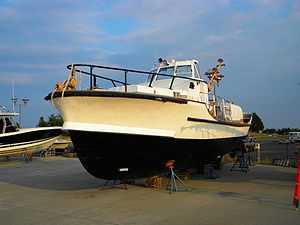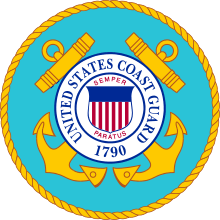44-foot motor lifeboat
 A former USCG 44′ MLB in drydock | |
| Class overview | |
|---|---|
| Name: | 44' MLB |
| Builders: |
USCG Yard, Curtis Bay, Maryland, USA Chantier maritimes du Saint-Laurent, Paspébiac, Quebec, Canada |
| Operators: |
|
| Cost: | $225,000 (circa 1972) |
| Building: | 110 |
| General characteristics | |
| Displacement: | 17.5 t (19 short tons)[1] |
| Length: | 44 feet (13 m)[1] |
| Beam: | 12.67 feet (3.86 m)[1] |
| Draught: | 3.3 feet (1.0 m)[1] |
| Speed: | 14 knots (16 mph; 26 km/h) (Cummins) 14 knots (16 mph; 26 km/h) (GM) |
| Range: | 215 nmi (398 km)[1] |
| Complement: | 4 crew |
The 44-foot motor lifeboat was the standard workhorse of the United States Coast Guard (USCG) rescue boat fleet.[1] The 44′ MLB has been replaced by the 47′ MLB.[2] The boats are powered by twin diesel engines, that each power a separate propeller.[3] The propellers are protected by the hull, to help prevent them being damaged if the boat runs aground. The boats have air-tight compartments forward and aft of the steering station. The aft compartment is designed to hold litters to strap in injured people, while the forward compartment hold uninjured rescues.
The magazine Popular Mechanics reported in 1966 that the then new fleet of 44 foot motor life-boats represented several "firsts".[3] The vessels were the first steel-hulled motor lifeboats—earlier vessels had hulls of wood. The vessels were the first motor lifeboats where a single crew member handled both the engine throttle and steering wheel. The vessels were the first motor lifeboats designed to automatically right themselves if overturned.
The Canadian Coast Guard operated 18 lifeboats acquired in 1966 using United States Coast Guard specifications.[4][5] Three other craft were obtained in 1975 and 1985 as training vessels.
Over the July 4th weekend of 1980 Richard Dixon, the coxswain of a 44-foot motor lifeboat from the US Coast Guard Station at Tillamook Bay lead his crew of four on two separate daring rescues, earning him the rare honor of two separate Coast Guard Medals.[6]
See also
- Waveney-class lifeboat
- Response Boat – Medium
- 36-foot motor lifeboat
- 47-foot Motor Lifeboat
- 52-foot Motor Lifeboat
- 41-foot Utility Boat, Large
- CCGS CG 117 and CCGS CG 118
References
- ↑ 1.0 1.1 1.2 1.3 1.4 1.5 "44-foot Motor Life Boat (MLB)". United States Coast Guard. 1998-12-23. Retrieved 2013-01-19.
- ↑ "Coast Guard bids adieu to 44-foot boat"
- ↑ 3.0 3.1 "Unsinkable high-powered rescue". Popular Mechanics. March 1966. pp. 146–147. Retrieved 2013-01-20.
First time in Coast Guard history, the helmsman is strapped to a seat where he also handles [the] throttle.
- ↑ http://www.44mlb.com/
- ↑ Thomas E. Appleton (2011-10-05). "USQUE AD MARE: A History of the Canadian Coast Guard and Marine Services". Canadian Coast Guard. Retrieved 2013-01-19.
The first of the new type, a 44-foot steel lifeboat capable of operation in any state of sea and weather, was stationed at Clarks Harbour, N.S in 1966. This vessel, one of a class designed and built by the United States Coast Guard, is self-righting and is subdivided by bulkheads to provide a high degree of watertight protection.
- ↑ Connie Braesch (2010-11-11). "Coast Guard Heroes: Richard Dixon". United States Coast Guard. Archived from the original on 2013-01-04.
Richard Dixon, a Boatswain's Mate stationed at Tillamook Bay, was awarded two Coast Guard Medals for his heroic actions on July Fourth weekend, 1980.
External links
| Wikimedia Commons has media related to USCG 44-foot motor lifeboat. |
| |||||||||||||||||||||||||||||||||
